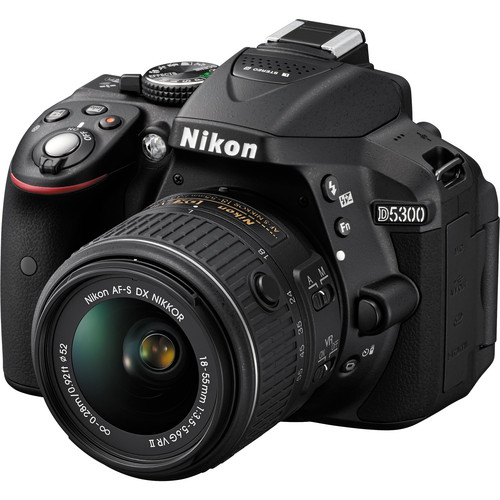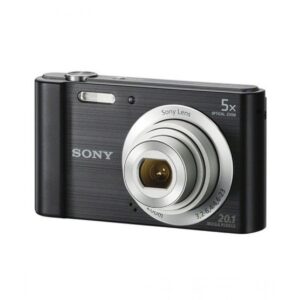The black Nikon D5300 DSLR Camera features a DX-format 24.2 megapixel sensor and EXPEED 4 image processor to produce high-resolution still imagery and full HD video with notable low-light sensitivity to ISO 12800 and a fast continuous shooting rate of 5 fps. The sensor design omits the traditional optical low-pass filter in order to gain the utmost sharpness and resolution from both photos and videos. Complementing the imaging assets are both a versatile 39-point autofocus system, with nine cross-type sensors, and a 2,016-pixel RGB sensor for precise exposure metering in a wide variety of lighting conditions. Additionally, 1920 x 1080p movie recording is supported, in multiple frame rates up to 60 fps, with full-time continuous auto focusing capabilities.
The compact, yet durably designed, camera body incorporates both an optical pentamirror optical viewfinder along with a large 3.2″ 1,037k-dot vari-angle LCD monitor, which features a 180° swivel design to better support working from high and low angles. Also integrated into the D5300 are both Wi-Fi and GPS modules, which enable advanced image sharing capabilities as well as location-based image tagging. When paired with an Android or iOS mobile device, remote viewing and control over the shutter release is possible from a distance and a vast network of pre-populated Points of Interest adds to the overall geotagging functionality.
For creatively enhancing the look and feel of imagery in-camera, a wide range of Picture Control modes, Scene Modes, and Special Effects modes are available as well as a host of in-camera image editing capabilities for adjusting settings prior to sharing. Built-in HDR and Active D-Lighting modes can also be used to optimize exposure results by preserving highlight and shadow details for an extended range of apparent tones.
Included with the D5300 camera body is the AF-S DX NIKKOR 18-55mm f/3.5-5.6G VR II lens; a standard zoom providing a 35mm-equivalent focal length range of 27-82.5mm. This lens incorporates a robust VR image stabilization system, which helps to minimize the appearance of camera shake by up to four shutter speed steps to benefit working in low-light conditions. A Super Integrated Coating reduces flare and ghosting to optimize image clarity, contrast, and color neutrality and a rounded seven-blade diaphragm works to create a pleasing out-of-focus quality in shallow depth of field images.
24.2MP DX-Format Sensor and EXPEED 4 Processor
Multi-CAM 4800DX Autofocus Sensor
When working in live view, for either still or movie shooting, a contrast-based AF system is employed to acquire focus precisely and can function in continuous, full-time servo mode to better suit working with moving subjects. Additionally, four AF-area modes are available when working in live view: Face-priority AF, Wide-area AF, Normal-area AF, and Subject-tracking AF.
Wi-Fi and GPS Connectivity
The integrated GPS functionality can be used to assign locational data to all image files for geotagging purposes and for plotting imagery to an interactive map. Points of Interest can also be found using this information to further aid in efficient location-based tagging.
Body Design
A built-in pop-up flash is also available for additional illumination when working in low-light conditions and supports Nikon’s i-TTL flash metering system. A hot shoe can be used, too, for connection and optional external flash for even greater lighting control.
Scene Recognition System and Exposure Metering
Full HD Movie Recording
A built-in stereo microphone can be used to record high-quality sound or, alternatively, a microphone input is integrated into the body design to support the use of an external microphone for enhanced control over audio recordings.
AF-S DX NIKKOR 18-55mm f/3.5-5.6G VR II Lens
Other Camera Features
- Picture Control modes can be directly accessed via a dedicated button and allow you to set predefined looks to imagery in-camera, and include Landscape, Monochrome, Neutral, Portrait, Standard, Vivid, and user-customizable settings.
- RAW (NEF) files can be recorded as lossless compressed or compressed at either 12 or 14-bit depth.
- Built-in HDR works to extend the tonal and exposure range of a single image by recording two separate exposures and blending them together in order to gain greater highlight and shadow details with an extended range of mid-tones.
- Active D-Lighting helps to preserve both highlight and shadow details when working in contrast-rich scenarios, such as backlit lighting. Utilizing the EXPEED 4 processor’s power, a more controlled image will be produced with brightness values closer to how they are naturally seen. This mode is suitable for working with moving subjects.
- Scene Auto Selector is an automatic mode that intelligently identifies your subject and shooting scenario, selects a proper Scene Mode to apply, and adjusts exposure settings to best render the scene at hand.
- Scene Modes: Autumn Colors, Beach / Snow, Blossom, Candlelight, Child, Close-up, Dusk / Dawn, Food, Landscape, Night Landscape, Night Portrait, Party / Indoor, Pet Portrait, Portrait, Sports, and Sunset.
- Special Effects Modes: Night vision, Color sketch, Toy camera, Miniature effect, Selective color, Silhouette, High key, Low key, and HDR painting.
- In-Camera Image Editing Features: Color Balance, Color Outline, Color Sketch, D-Lighting, Distortion Control, Edit Movie, Filter Effects, Fisheye, Image Overlay, Miniature Effect, Monochrome, NEF (RAW) Processing, Perspective Control, Quick retouch, Red-Eye Correction, Resize, Selective Color, Side-by-Side Comparison, Straighten, and Trim.






